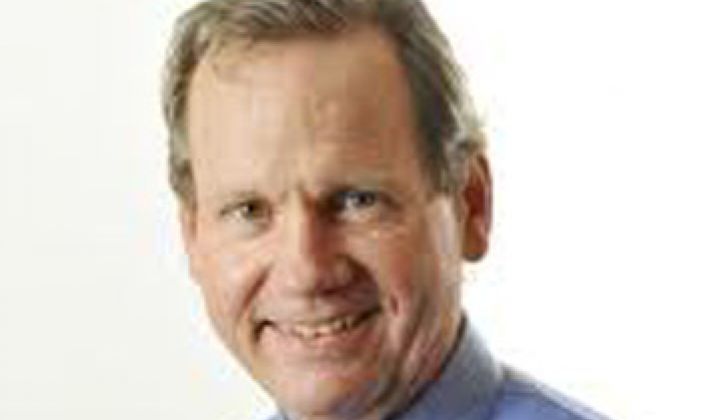High power bills aren’t a liability. They are an asset, according to Christopher Curtis, president and CEO of the North American Operating Division of Schneider Electric.
Under the right circumstances, large institutions can cover the cost of retrofits through the reductions in their energy bills that the retrofits will accomplish, he said during a recent interview. Most industrial customers want to see upgrades paid off in three years or less, which limits which repairs can be accomplished. However, city and state governments are examining retrofit deals that get amortized over a period of 10 to 20 years.
“It is counterintuitive, but the potential for savings is the asset that plays for a capital upgrade,” Curtis said. “The note is paid out of the maturity of the savings. There is no financial outlay. You are financing the note out of the system itself.”
Schneider, which began in France during the Napoleonic era, and competitors like General Electric, Siemens and ABB potentially sit on the threshold of a new, rosy era.
Large corporations, particularly those with large data centers, are increasingly worried about the rising cost and availability of power. They’ve also come to recognize that they waste quite a bit of energy. Meanwhile, utilities provide power but, because of their role in the energy food chain and their status as quasi-public institutions, they may not always be able to adequately serve as energy advisors or managers. Into that breach will step the large electrical services and equipment providers with demand response programs, continuous commissioning and other services to help navigate the relationship between power producers and consumers.
“ESCOs (energy service companies) were a cottage industry twenty years ago,” he said. “Now you’ve got large suppliers that are offering performance-based services. They are offering guarantees.”
The growth in demand response highlights the potential for the services companies. While some have theorized that utilities will absorb demand response and provide their own services, Curtis argues that the inherent conflicts between a utility (which wants as much capacity as it can get, as soon as it can get it) and its customers (who care more about the smooth running of their own operations) will prevent that from happening.
“When you talk about demand response, it is the avenue for connecting demand to supply. Is it something that automatically occurs? That is an interesting question. If it did, it would defy all historical logic to this point,” he said. “Demand response is a long ways from being a commodity. In fact, it is a question if it every will become a commodity because everyone’s situation is different.”
The signals in the market back this up. Schneider gets a request for proposal for demand response services from a utility once a week.
“It makes more sense that it will remain a service,” he added.
Other things on Curtis’ mind:
--Lighting networking and management will likely become a growth segment. “It is usually the second biggest opportunity from an energy efficiency standpoint,” he said. “The majority of buildings don’t have lighting controls other than a switch.”
Unlike heating and air conditioning, however, managing lighting requires quite a bit of nuance, so service companies have to be cognizant of lighting quality, the potential for daylight harvesting and other issues. In other words, efficiency engineers will have to talk to designers. The opportunity here will lay in “efficient space management,” he said.
--Storage will help solar reach parity with fossil fuels by giving utilities and power providers the ability to dispatch power only when needed.
“The biggest trigger for getting to independence will be storage,” he said. “Today, you are producing power (with solar) in the same fashion you would in our inefficient grid. You are producing it whether anyone is using it or not. Once you are able to store solar power and use it efficiently, you will come down the cost curve.”
--Electric vehicles will likely grow faster initially in Europe and China than North America. In the U.S., the rise of electric cars may ultimately require adding about ten percent of additional capacity to the grid. That will become another driver for demand response services.
“I don’t see how we could solve the capacity challenges fast enough,” he said.
--IT equipment like sensors and routers are “the modern version of wire” for the grid. That is, they will become part of the equipment backbone, but services will always ride on top of them.
--Everyone loves the idea of the smart grid in the industry, but standards have to be hammered out. The public also has yet to be convinced of what it is and how it will benefit them.
“You’ve got a relatively uniformed public that hasn’t been educated [on smart grid concepts]. If you ask 15 people about smart grid, you will get 15 different answers,” he said.
--Perhaps the most unpredictable wild cards these companies are facing will be public policy and regulation.
On one hand, regulations have helped drive the market. The federal government wants to improve the efficiency in its facilities by two percent annually. New York City has passed regulations that require building owners to recommission their buildings periodically.
“Buildings don’t behave the way we think they should, nor do they stay static,” he said.
On the other hand, the voters have spoken.
“One of the unfortunate consequences of the recent election is that it probably put climate legislation a bit on the back burner, which is not necessarily a good thing in my opinion,” he said. “When you travel globally, you see a lot of countries being more progressive than we are, but we are the biggest per capita consumer of energy by far. Yet we’ve been on the sidelines."
“This is a country that acts terrifically in a crisis,” he added. “Preventing them? Well, we’re not so hot at that.”



